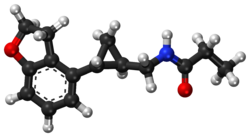タシメルテオン
 | |
 | |
| IUPAC命名法による物質名 | |
|---|---|
| |
| 臨床データ | |
| 販売名 | Hetlioz |
| 胎児危険度分類 |
|
| 法的規制 |
|
| 投与経路 | Oral |
| 薬物動態データ | |
| 生物学的利用能 | not determined in humans[1] |
| 血漿タンパク結合 | 89–90% |
| 代謝 | extensive hepatic, primarily CYP1A2 and CYP3A4-mediated |
| 半減期 | 0.9–1.7 h / 0.8–5.9 h (terminal) |
| 排泄 | 80% in urine, 4% in feces |
| 識別 | |
| CAS番号 |
609799-22-6 |
| ATCコード | N05CH03 (WHO) |
| PubChem | CID: 10220503 |
| IUPHAR/BPS | 7393 |
| ChemSpider |
8395995 |
| UNII |
SHS4PU80D9 |
| ChEBI |
CHEBI:79042 |
| 化学的データ | |
| 化学式 | C15H19NO2 |
| 分子量 | 245.32 g/mol |
| |
タシメルテオン︵Tasimelteon︶は、メラトニン受容体のMT1 とMT2 に対する選択的作動薬である[2]。初めて承認されたラメルテオンやアゴメラチンと同様、メラトニン受容体作動薬である[2]。
アメリカ食品医薬品局 (FDA) に承認された医薬品で[3]、2014年1月に非24時間睡眠覚醒症候群の治療に適応がある
[4]。欧州医薬品庁は同年6月にタシメルテオンの出願を受け[5]、2015年6月に、全盲の成人のための非24時間睡眠覚醒症候群︵none 24︶の適応を承認した[6]。しかし、これはこの症候群の少数である。Hetlioz の商品名で知られる。
非24時間睡眠覚醒症候群の治療中には、メラトニンや他の派生薬のように、服用者は服用する期間において睡眠の時期が改善されることを実感する。元の睡眠への復帰は、服薬を中断してから一か月以内に起こる[7]。
毒性[編集]
げっ歯類では、受精障害や、特定のがんの増加、妊娠中の重大な有害事象が、人での服用量とされる量を超過した用量で明らかとなっている[8][9]。関連項目[編集]
- en:Melatonin receptor agonist#Drug design and development メラトニン受容体作動薬の発見と開発。
出典[編集]
(一)^ “Tasimelteon Advisory Committee Meeting Briefing Materials”. Vanda Pharmaceuticals Inc. (2013年11月). 2017年1月30日閲覧。
(二)^ abVachharajani, Nimish N.; Yeleswaram, Krishnaswamy; Boulton, David W. (April 2003). “Preclinical pharmacokinetics and metabolism of BMS-214778, a novel melatonin receptor agonist”. Journal of Pharmaceutical Sciences 92 (4): 760–72. doi:10.1002/jps.10348. PMID 12661062.
(三)^ “FDA transcript approval minutes”. FDA (2013年11月14日). 2017年1月30日閲覧。
(四)^ Food and Drug Administration (2014年1月31日). “FDA approves Hetlioz: first treatment for non-24 hour sleep-wake disorder”. FDA
(五)^ “tasimelteon (Hetlioz) UKMi New Drugs Online Database”. 2014年8月6日閲覧。
(六)^ “HETLIOZ® Receives European Commission Approval for the Treatment of Non-24-Hour Sleep-Wake Disorder in the Totally Blind”. MarketWatch. PR Newswire (2015年7月7日). 2015年7月8日閲覧。
(七)^ Sack, R. L.; Brandes, R. W.; Kendall, A. R.; Lewy, A. J. (2000). “Entrainment of Free-Running Circadian Rhythms by Melatonin in Blind People”. New England Journal of Medicine 343 (15): 1070–7. doi:10.1056/NEJM200010123431503. PMID 11027741.
(八)^ “Side Effects Drug Center: Hetlioz Clinical Pharmacology”. RxList (2014年2月10日). 2017年1月30日閲覧。
(九)^ “Side Effects Drug Center: Hetlioz Warnings and Precautions”. RxList (2014年2月10日). 2017年1月30日閲覧。 “In animal studies, administration of tasimelteon during pregnancy resulted in developmental toxicity (embryofetal mortality, neurobehavioral impairment, and decreased growth and development in offspring) at doses greater than those used clinically.”
